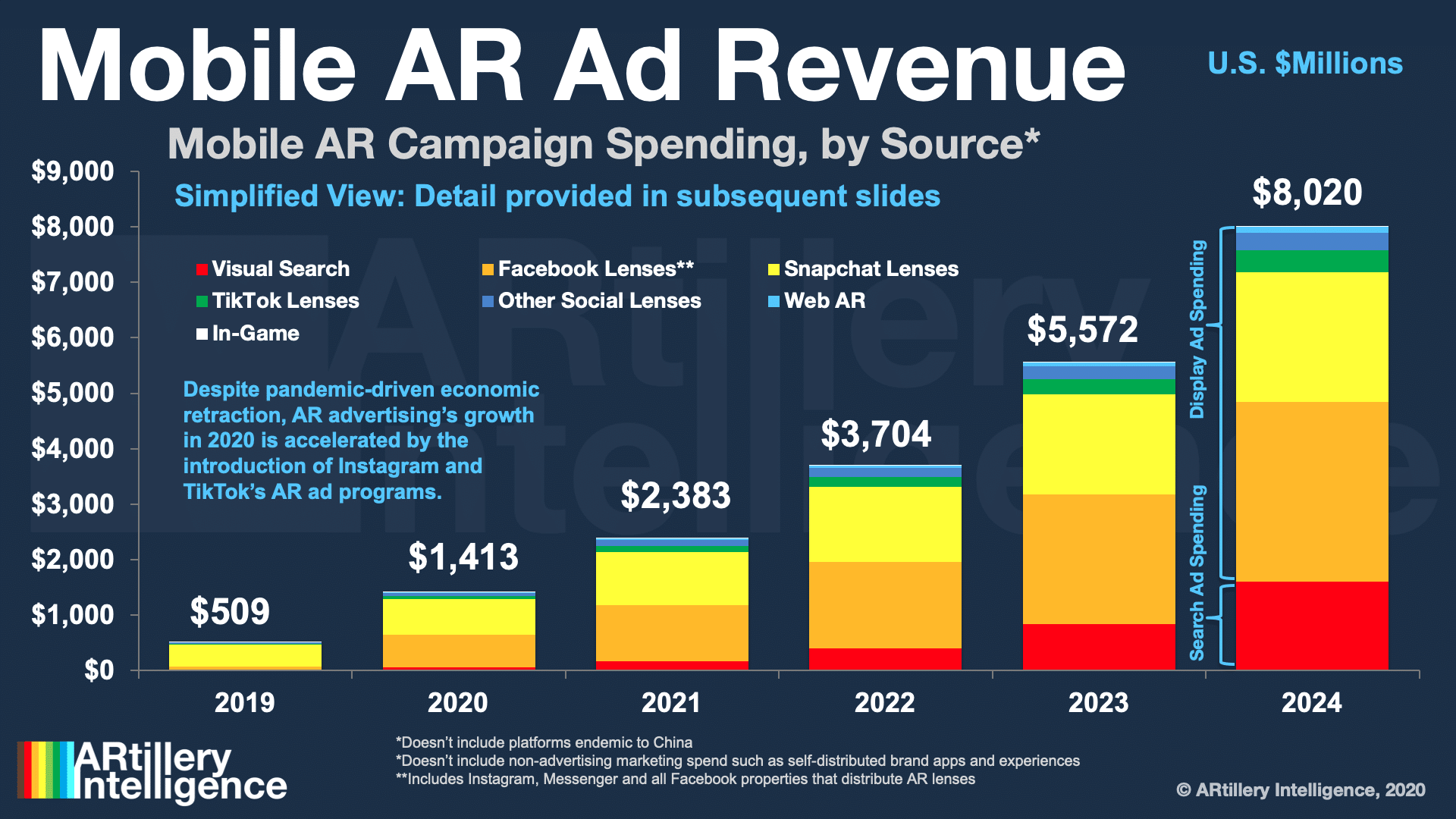
![]() This post is adapted from ARtillery Intelligence’s report, AR Advertising Deep Dive, Part I: The Landscape. It includes some of its data and takeaways. More can be previewed here and subscribe for the full report.
This post is adapted from ARtillery Intelligence’s report, AR Advertising Deep Dive, Part I: The Landscape. It includes some of its data and takeaways. More can be previewed here and subscribe for the full report.
AR continues to evolve and take shape as an industry. Prominent sectors include industrial AR, social, gaming, and shopping. But existing alongside all of them is AR advertising. This includes paid/sponsored AR lenses that let consumers visualize products on “spaces & faces.”
Advertising is one of the most lucrative AR subsectors, on pace to reach $1.41 billion this year and $8.02 billion by 2024. These figures measure the money spent on sponsored AR experiences with paid distribution on networks like Facebook and Snapchat.
As we’ve examined in past reports, the factors propelling this revenue growth include brand advertisers’ growing affinity for AR. Its ability to demonstrate products in immersive ways resonates with their creative sensibilities, transcending what’s possible in 2D formats.
Beyond that high-level appeal, there’s a real business case. AR ad campaigns continue to show strong performance metrics. This was the case in “normal” times and has accelerated during the Covid era when retail lockdowns compel AR’s ability to visualize products remotely.

Naming Names
Picking up where we left off last week in defining AR advertising, it’s now time to name names. Snap has the most AR traction given its “camera company” focus. But Facebook has the most scale, where it continues to integrate AR in the News Feed, Portal, Messenger.
But Instagram could be Facebook’s real AR play. Not only did it integrate Facebook’s Spark AR lens developer platform, but it’s more natively aligned with visual shopping than other Facebook properties. It has cultivated a strong use case for product discovery in fashion and food.
Instagram has also become more transactional over the past few years. With AR, that shopping use case is now infused with more dimension through interactive product try-ons. This could be a powerful combination that attracts ad dollars to promote and amplify branded AR lenses.
Meanwhile, other players loom. Beyond social lenses, visual search could eventually be a more powerful AR modality. For those unfamiliar, visual search lets you hold up your phone for descriptive overlays to contextualize (or buy) a given product you see in the real world.
History Repeats
Building from the high-intent qualities of web search, visual search is a true utility as it develops from Google and Pinterest. Google is motivated towards apps like Google Lens to future proof its core businesses. And visual search is naturally monetizable… just like web search.
Boiling it down, the flavors of AR advertising include AR visualization (placing a 3D product in your space), and visual search (using AR overlays to get info on a real-world object). That makes AR map to the main divisions of digital advertising we know today: display and search.
In fact, when looking at the interplay of AR lenses and visual search, they could follow an evolutionary path similar to display and search ads online. Display was out of the gate first as an ad format (just like lenses lead today), but then search developed as a late bloomer.
Could we see AR follow the same path? We’ll dive into each of these main subdivisions of AR advertising and their players in this report. We’ll do so in their order of real-world appearance, given the marketing-evolution sequence examined above. So naturally, we’ll start with lenses.
First Mover
Lenses are the most popular AR flavor today. That goes for consumers, as they lean in to overlays that help them produce and share animated selfies. Advertisers have followed those eyeballs and leaned in to the creative capacity that AR affords for 3D product visualization.
This started with face filters as people like to see and share their own faces. This has presented natural opportunities to a range of products that go on your face. We’re talking cosmetics, sunglasses and other fashion fodder that fits with existing product discovery in social media.
But could the larger opportunity be to flip the orientation to the rear-facing camera that looks outward at the physical world? Could that present a broader canvas for real-world augmentation? This would open the opportunity to many more product categories.
We believe this is where the growth in AR lens-based advertising lies. Facebook has already gone down this road with location-based lenses. Snapchat has World Lenses, Landmarkers, and other rear-facing use cases for local discovery that will continue to develop.
We’ll pause there and circle back in the next installment to continue the discussion of how the AR advertising landscape is materializing. That includes a deep dive on visual search, and profiles of companies planting a stake in AR advertising. Check out the full report here.





